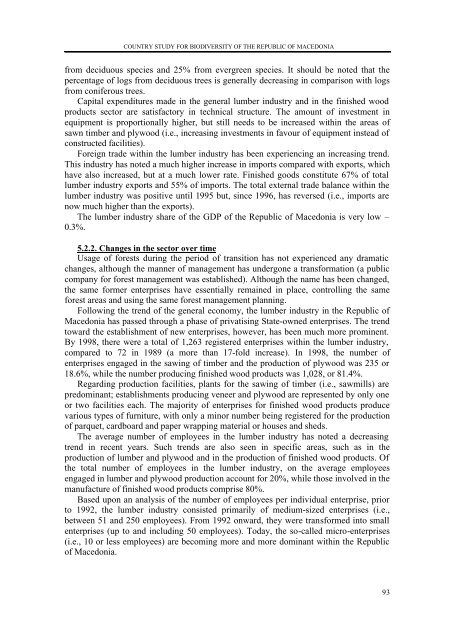English - Convention on Biological Diversity
English - Convention on Biological Diversity
English - Convention on Biological Diversity
You also want an ePaper? Increase the reach of your titles
YUMPU automatically turns print PDFs into web optimized ePapers that Google loves.
COUNTRY STUDY FOR BIODIVERSITY OF THE REPUBLIC OF MACEDONIA<br />
from deciduous species and 25% from evergreen species. It should be noted that the<br />
percentage of logs from deciduous trees is generally decreasing in comparis<strong>on</strong> with logs<br />
from c<strong>on</strong>iferous trees.<br />
Capital expenditures made in the general lumber industry and in the finished wood<br />
products sector are satisfactory in technical structure. The amount of investment in<br />
equipment is proporti<strong>on</strong>ally higher, but still needs to be increased within the areas of<br />
sawn timber and plywood (i.e., increasing investments in favour of equipment instead of<br />
c<strong>on</strong>structed facilities).<br />
Foreign trade within the lumber industry has been experiencing an increasing trend.<br />
This industry has noted a much higher increase in imports compared with exports, which<br />
have also increased, but at a much lower rate. Finished goods c<strong>on</strong>stitute 67% of total<br />
lumber industry exports and 55% of imports. The total external trade balance within the<br />
lumber industry was positive until 1995 but, since 1996, has reversed (i.e., imports are<br />
now much higher than the exports).<br />
The lumber industry share of the GDP of the Republic of Maced<strong>on</strong>ia is very low –<br />
0.3%.<br />
5.2.2. Changes in the sector over time<br />
Usage of forests during the period of transiti<strong>on</strong> has not experienced any dramatic<br />
changes, although the manner of management has underg<strong>on</strong>e a transformati<strong>on</strong> (a public<br />
company for forest management was established). Although the name has been changed,<br />
the same former enterprises have essentially remained in place, c<strong>on</strong>trolling the same<br />
forest areas and using the same forest management planning.<br />
Following the trend of the general ec<strong>on</strong>omy, the lumber industry in the Republic of<br />
Maced<strong>on</strong>ia has passed through a phase of privatising State-owned enterprises. The trend<br />
toward the establishment of new enterprises, however, has been much more prominent.<br />
By 1998, there were a total of 1,263 registered enterprises within the lumber industry,<br />
compared to 72 in 1989 (a more than 17-fold increase). In 1998, the number of<br />
enterprises engaged in the sawing of timber and the producti<strong>on</strong> of plywood was 235 or<br />
18.6%, while the number producing finished wood products was 1,028, or 81.4%.<br />
Regarding producti<strong>on</strong> facilities, plants for the sawing of timber (i.e., sawmills) are<br />
predominant; establishments producing veneer and plywood are represented by <strong>on</strong>ly <strong>on</strong>e<br />
or two facilities each. The majority of enterprises for finished wood products produce<br />
various types of furniture, with <strong>on</strong>ly a minor number being registered for the producti<strong>on</strong><br />
of parquet, cardboard and paper wrapping material or houses and sheds.<br />
The average number of employees in the lumber industry has noted a decreasing<br />
trend in recent years. Such trends are also seen in specific areas, such as in the<br />
producti<strong>on</strong> of lumber and plywood and in the producti<strong>on</strong> of finished wood products. Of<br />
the total number of employees in the lumber industry, <strong>on</strong> the average employees<br />
engaged in lumber and plywood producti<strong>on</strong> account for 20%, while those involved in the<br />
manufacture of finished wood products comprise 80%.<br />
Based up<strong>on</strong> an analysis of the number of employees per individual enterprise, prior<br />
to 1992, the lumber industry c<strong>on</strong>sisted primarily of medium-sized enterprises (i.e.,<br />
between 51 and 250 employees). From 1992 <strong>on</strong>ward, they were transformed into small<br />
enterprises (up to and including 50 employees). Today, the so-called micro-enterprises<br />
(i.e., 10 or less employees) are becoming more and more dominant within the Republic<br />
of Maced<strong>on</strong>ia.<br />
93
















